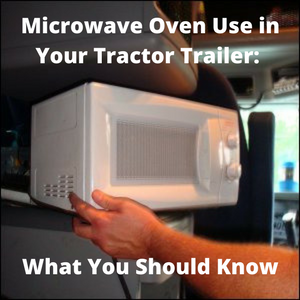
You may quickly and easily cook or reheat food in a microwave oven.
These appliances utilize electromagnetic waves with a wavelength between that of infrared light and radio waves.(1)
Before you buy and use one in your 18-wheel tractor trailer truck, here is what you will need to consider.
Application
How will you be using your appliance?
If you plan to cook larger meals from scratch, your needs will be different from someone who will only be reheating food.
For many drivers, smaller microwave ovens work well to cook or reheat smaller portions.
For a number of years, Mike used a Sunbeam SBM7700W in his truck. The personal photos below show this unit.
If you are looking to use such an appliance in your truck, you may wish to consider the following specifications:
- cubic feet of cooking space;
- number of watts of power;
- number of power levels;
- number of minutes on the timer;
- whether or not it has a rotating glass turntable that can be removed for easy cleaning; and
- its exterior dimensions (for purposes of planning storage and organization in your truck).
You will need to determine what combination works best for you.
Some foods cook or reheat better than others in these devices.
We’ve found that pizza gets soggy when reheated this way.
It is best to reheat dishes like pizza and impossible spinach pie — that have a crust — in a Jet Stream Oven, so that they’ll be a little crispy on the edges.
Power Levels
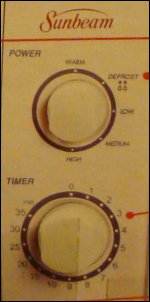 Before you buy your unit, consider both the number of watts that it will use and the power levels of cooking.
Before you buy your unit, consider both the number of watts that it will use and the power levels of cooking.
Using a lower power level will enable you to cook food more slowly (such as for defrosting purposes).
Using a higher power allows faster cooking but can also ruin foods.
Vicki once burned a bag of microwave popcorn by popping it on too high a setting.
The popcorn was inedible and the burnt smell lingered in the room for a long time.
Regarding the number of watts, you will want to make sure that your truck’s electrical system can handle it.
We cover this a little more fully below…
Safe Containers
You are probably aware that some items are just not microwave-friendly.
Thin plastic storage containers can melt.
Metal cannot generally be microwaved, although one exception seems to be the metal rings on microwavable foods with pop-top lids, the lids of which are removed and the rings being re-covered by the plastic tops.
For your convenience, we have listed some products here from Amazon.com, with which we have an affiliate relationship.
If you are intent on using this kind of cooking appliance in your truck, you may want to invest in a few pieces of “microwave safe” cookware.
Some people have great success using Pyrex clear glass containers, which supposedly don’t warp, stain or absorb odors; furthermore, they may be used in the refrigerator, oven and microwave.
Microwaving the plastic lids is not recommended, even though they do have steam vents.
12-Volt Units
You may see some “12-volt” microwave ovens for sale, but they always seem to come with an inverter and wiring kit (which we frankly don’t understand).
We don’t think it is possible for these appliances to draw enough power to run from a cigarette lighter unless they draw an extremely low number of watts (in which case it will take longer to cook your food).
After our mixed results experience with 12-volt Pot-n-Pops, we have steered clear of most all 12-volt appliances, especially those with a cheapo 90-day warranty.
We have found them to be of inferior quality and quite flimsy.
Anyone seriously considering the use of an appliance of any kind in a commercial motor vehicle would be well served, in our opinion, to invest in a standard 120-volt household appliance which can be run from an inverter.
Do yourself a big favor and research this matter for yourself.
We’ve been burned (figuratively) and want to help you not be.
Naturally, you will want to purchase a microwave oven that draws no more power than your inverter can provide and will store fairly easily in your truck.
Instead of investing in a specialty 12-volt appliance (that can be used only with a DC power source), we have found it beneficial to use the same kind of appliance in our trucks that we use at home so that we don’t double up on appliances.
You may have a different opinion.
Exterior Dimensions and Storage Considerations
In one of the trucks that Mike drove, he used a compact refrigerator.
He was able to place a microwave oven on top of it and lash it down via bungee cords or rubber tie downs to the floor.
This illustration shows the placement of the unit in the truck (not showing the tie downs).
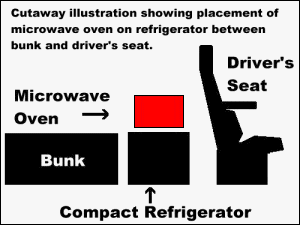
In making way for the placement of the refrigerator on the floor, he had to remove the cabinet.
After he had problems using a refrigerator, Mike switched to using an ice chest to keep his cold food cold.
In another truck he drove for his trucking company, he left the cabinet behind the driver’s seat intact.
There was space under this cabinet into which to slide the ice chest.
In that truck, he stored a microwave oven in the cabinet behind the passenger seat.
See him removing it from that cabinet in this photo.
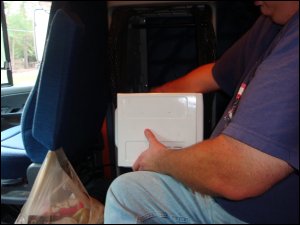
He then set it on the cabinet behind the driver’s seat.
He plugged the power cord into a surge protector strip plugged into the inverter.
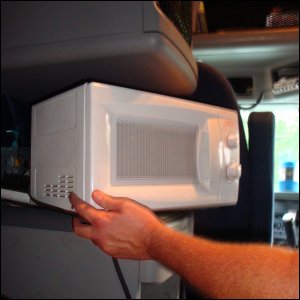
Dangers of Microwave Oven Use
Because these appliances use microwave energy to cook food, there are dangers associated with their operation. For your consideration, we are providing links to these two articles from Dr. Joseph Mercola:
- articles.mercola.com/sites/articles/archive/2010/05/18/microwave-hazards.aspx (no longer online)
- mercola.com/article/microwave/hazards2.htm (no longer online).
For those who are concerned about the quality of the food they eat, we feel that an article published in August 2012 with the title “Studies Show Microwaves Drastically Reduce Nutrients in Food” is worth the time to read.
Superheating
According to a page (and video) on the website of the University of New South Wales, Sydney, Australia(2):
There have been many reports of injury to people using microwave ovens to heat water to make hot drinks. Water heated in a microwave oven may be superheated and when objects (e.g. a spoon) or granulated materials (e.g. instant coffee) are put into it, the water may boil very vigorously or even appear to explode out of the container. The vigorously ejected boiling water can cause serious burns. Sometimes even the act of taking the container out of the oven and or putting it on the bench can cause the boiling.
Beware of this phenomenon and avoid setting up conditions to cause superheating from a microwave oven.
Our Experience
When Mike used a microwave oven to cook for himself alone in his truck, he relied on it about 80% or more of the time compared to other appliances — because he was warming up food already prepared by his home support team.
It was easy to pull a container of food from his ice chest, move the food into a “microwave-safe” container, add a little water, and “heat it up and eat it up.”
From both a time saving perspective and health perspective, we got to the point when Vicki was riding with Mike that we used a hot pot for cooking many meals.
Not only was it taking way too long to “zap” (heat) the quantity of food needed to feed two people but we didn’t want the harmful effects of radiating our food.
Helpful Hint
To keep the glass turntable inside the microwave from rattling while he was driving, Mike wrapped it in a thick cloth towel and put it back on the carousel before storing it away.
![]() Money saving tip: Even though purchasing a microwave oven may be a significant investment, add up all of the savings from the meals you can cook in your truck instead of eating out on the road.
Money saving tip: Even though purchasing a microwave oven may be a significant investment, add up all of the savings from the meals you can cook in your truck instead of eating out on the road.
There are many, many dishes, whether prepared at home or commercially, that can be cooked or reheated and eaten on the road.
We strongly encourage you to measure the space where you are considering storing the unit in your truck before buying one so you don’t buy one that is too large.
Compare the features that you are most likely to use versus the price.
Some units have other functions besides just microwaving, such as a convection oven.
Research these prior to purchase so that you know what you’re getting.
Return from Microwave Oven Use in Your Tractor Trailer: What You Should Know to our Meal Preparation page or our Truck Drivers Money Saving Tips home page.
References:
1. http://en.wiktionary.org/wiki/microwave
2. http://www.phys.unsw.edu.au/~jw/superheating/











